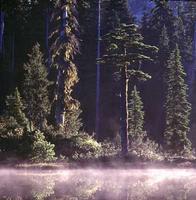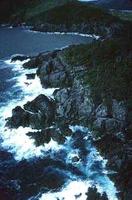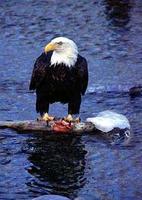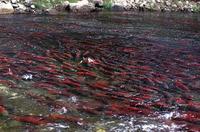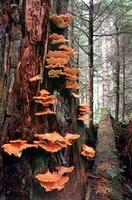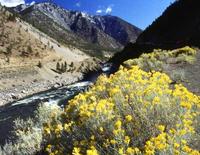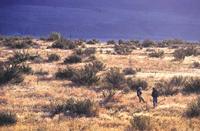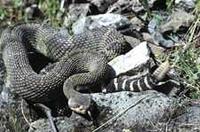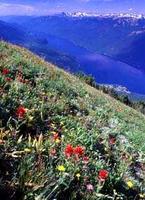Natural History of BC
British Columbia is home to more species of living things than any other Canadian province (see BIODIVERSITY). Although the reasons for this rich assemblage of species can be attributed largely to topographic and climatic diversity, other factors are in BC's favour as well. The intricate topography of the province juxtaposes MOUNTAINS, plateaus, valleys and coastal plains with their associated LAKES, RIVERS and WETLANDS to form myriad complex and varied ecosystems. Some species of animals and plants are endemic to BC, meaning that they are not known to occur anywhere else in the world. Perhaps the best known of these is the Vancouver Island MARMOT, a large, chocolate-brown relative of the woodchuck found only on the high mountain meadows of central VANCOUVER ISLAND. Fewer than 200 of these animals survive, making it one of the rarest mammals in the world. Also endemic to BC are 168 insect and 6 plant species, most of them restricted to the coast.
Two systems that identify and map BC's ecological diversity are widely used today. Vladimir KRAJINA developed a system of BIOGEOCLIMATIC ZONES, which are areas characterized by climatic factors and defined according to the tree and shrub species that dominate in climax FORESTS within them. Examples of the 14 major zones are the Coastal Western Hemlock Zone along most of the coast, the Ponderosa Pine Zone in dry Interior valleys, and the Spruce-Willow-Birch Zone that occurs interspersed among the boreal forest and alpine tundra zones in the north. The second system is the ECOREGION CLASSIFICATION SYSTEM developed by Dennis Demarchi, in which BC is divided into 10 ecoprovinces, including the Southern Interior Mountains in the KOOTENAY and COLUMBIA MTS regions, the Boreal Plains around the PEACE R, and the Georgia Depression, which includes eastern Vancouver Island and the Lower Mainland. Both classification systems have many smaller divisions grouped below the main categories.
The Marine World
BC has a rich marine environment that supports several giant species such as the largest OCTOPUS, SEA STAR and CHITON in the world. Cold, upwelling waters bring nutrients to the highly productive coastal ecosystems, which are also enriched at ESTUARIES from the many rivers emptying at the coast. These nutrients feed a soup of tiny plants, the phytoplankton, which in turn are eaten by clouds of zooplankton and other small invertebrates such as copepods and EUPHAUSIIDS, or krill. As coastal waters warm up in summer, the phytoplankton are sometimes dominated by dinoflagellates to create a red tide (see HARMFUL ALGAL BLOOMS).
The coastal environment is as diverse as the terrestrial environment. In sheltered, rock-bottomed bays, KELP forests sway in the waves sheltering schools of FISH and many species of invertebrates on the blades of the kelp and on the ocean floor. Shallow, sandy or muddy shorelines are often characterized by eelgrass meadows, underwater prairies of waving grass that host a unique community of animals and attract thousands of waterfowl every year, including the Brant GOOSE. Offshore islands are breeding grounds for millions of seabirds. AUKLETS, MURRELETS, MURRES, PUFFINS and STORM-PETRELS burrow into the turf or lay their eggs on rocky cliffs in their annual contact with land. TRIANGLE ISLAND, an ECOLOGICAL RESERVE off the northern tip of Vancouver Island, hosts the largest number, including a million Cassin's auklets.
Two wildlife spectacles of note occur annually in BC coastal waters. In spring, Pacific HERRING spawn in huge numbers in bays and channels up and down the coast. These concentrations bring in SEALS, SEA LIONS, thousands of DUCKS, LOONS, GREBES, GULLS and other water birds, and help feed the gray WHALES on their northward migration. The second spectacle is the annual migration of SALMON to their spawning streams. As the schools of big silver fish leave the open ocean and pass through JOHNSTONE STRAIT and down toward the GULF ISLANDS, KILLER WHALES follow them in, providing unparalleled viewing opportunities. The salmon swim inland, up the rivers and streams where they were born, to spawn and die, sometimes hundreds of kilometres from the sea. Their presence and subsequent death provides a tremendous bounty for terrestrial ecosystems and land animals. BEARS, RACCOONS and other mammals catch migrating salmon live, or feast on the carcasses, while mergansers, goldeneye, DIPPERS and other birds dive for the eggs. Thousands of bald EAGLES gather each winter at sites of chum and coho salmon spawns, most notably at BRACKENDALE on the SQUAMISH and CHEAKAMUS rivers and at Chehalis Flats on the HARRISON R.
Forest Worlds
Salmon runs are one reason why the temperate RAIN FORESTS along the coast of BC are so productive. The mild winters and abundant rainfall are also important factors. Some of the tallest trees in the world grew along the coast, and a few huge DOUGLAS FIRS, western red CEDAR, western HEMLOCK and Sitka SPRUCE remain (see TREES, GIANT). Western hemlock forests produce about 5 tonnes of plant material per hectare each year, and some very rich sites produce more than 30 tonnes per year. In these forests of giant trees, some of the most important organisms are very small. Fungi are essential elements of these ecosystems; some species connect with the roots of trees to provide them an extra boost in obtaining nutrients in return for sugars produced in the greenery above. Other fungi team up with algae to form lichens, once thought to be benign curiosities, but now known to be important providers of nitrates to a nutrient-poor ecosystem. Important vertebrates include tiny SALAMANDERS, living at a density of about 200 per hectare, and northern flying SQUIRRELS, which eat lichens and fungi, and then spread their valuable spores through the forest.
Along the southeast coast of Vancouver Island and on the Gulf Islands, winter rainfall is considerably less and the summer drought stronger. Here the natural forest is an open savannah of Garry OAK, ARBUTUS and Douglas firs. This habitat is one of the most endangered ecosystems in Canada. At higher elevations in the COAST MTS the winter rains turn to snow and the rain forests become snow forests. Mountain hemlocks, yellow cedars and amabilis FIRS manage to germinate and grow in forests where it is common to have 5 m or more of snow on the ground, often lingering into July. With very little chance of summer FOREST FIRES or other large disturbances, these ancient forests were once filled with ancient trees. One yellow cedar on the Sechelt Peninsula's Caren Range was almost 1,700 years old, and there are still a few trees in CYPRESS PROVINCIAL PARK above W VANCOUVER that range between 1,600 and 1,200 years old.
Forests of the Interior mountains and plateaus are quite different from coastal forests, and are dominated by Engelmann spruce and subalpine fir. These forests are characterized by long, cold winters and short, warm summers and are similar in many ways to the boreal forests of northern BC, which are dominated by white and black spruce, WILLOW and BIRCH. Forests of north and south share many of the same animals and their understories are both characterized by MOSSES, lichens, and plants of the heather family—for example kinnikinnick, blueberries, huckleberries, and RHODODENDRONS. Much of the mountain and boreal forests of BC are now covered by lodgepole PINE, an early colonizing species that needs high temperatures to open its cones and cleared areas to germinate in full sunlight. Both needs are met by forest fires, which have cleared thousands of hectares of the Interior over the last century. Another species that benefits from fire is the trembling aspen. The dominant animal in spruce forests is the snowshoe hare (see RABBIT AND HARE), which has a dramatic 10-year population cycle. When the hares are abundant, their predators—LYNX, great horned OWL, red FOX, COYOTE, northern goshawk and others—increase in population as well. This increase in predators drives down the hare population after 2 years, and numbers remain low until they surge upwards about 8 years later. There is some evidence that the population increase is linked to CLIMATE changes locked into the 10-year cycle of sunspot activity.
The low elevation forests of the dry western portion of the southern Interior are dominated by Douglas fir and ponderosa pine, with western LARCH growing in moister areas. These dry southern Interior valleys have short, cool winters and long, hot summers, and the forests have an open understorey containing abundant grasses, fescues, SOOPOLALLIE and kinnikinnick. Indeed, as one moves down in elevation, this becomes a parkland environment in pure ponderosa pine stands. These are forests shaped by fire; both the pines and Douglas firs have thick bark to protect them from ground fires that periodically clear out shrubs and small trees. The larch, like the lodgepole pine, needs fires to create the bare soil it needs to germinate. Ponderosa pine forests in particular have a number of birds restricted to them. The white-headed WOODPECKER, Canada's rarest woodpecker and an ENDANGERED SPECIES, is found only in the pine forests of the south OKANAGAN VALLEY. Pygmy NUTHATCHES are one of the commonest birds in these forests and are hardly ever seen in any other habitat. The flammulated owl, a small insect-eating species, is locally common in mixed ponderosa pine and Douglas fir forests.
At lower elevations in the west Kootenay and north to the BOWRON LAKE region, heavy winter snowfalls and frequent summer rains produce a very diverse forest reminiscent of the coastal rain forest. This is the area commonly called the Interior "Wet Belt" and forests here are dominated by western hemlock and western red cedar. Common understorey plants here include devil's club and skunk cabbage.
Grasslands
In southern Interior valley bottoms from the Fraser and Thompson through the Okanagan and in parts of the southern ROCKY MT TRENCH, the summers are too hot and dry to allow tree germination. Here the natural ecosystem is a semi-arid GRASSLAND dominated by bunchgrasses and shrubs, notably big sagebrush, rabbitbrush and antelope-brush. Brittle prickly-pear cactus is common, and the list of animal species sounds very desert-like: scorpions, black widow SPIDERS, RATTLESNAKES and even pygmy short-horned LIZARDS. The grasslands of BC have been divided into 3 groups, roughly based on elevation. The lower grasslands are characterized by bluebunch wheatgrass, often growing with big sagebrush, mostly found in the Thompson–Okanagan area. The middle grasslands, dominated by bluebunch wheatgrass and Sandberg's bluegrass, have few shrubs, usually common rabbitbrush, and are typical of the NICOLA Valley. The upper grasslands are usually dominated by fescues, but on the CARIBOO and CHILCOTIN plateaus wheatgrasses and needlegrasses are important species. Much of BC's native grasslands have been converted to intensive AGRICULTURE, and the antelope-brush grasslands of the southern Okanagan are considered one of Canada's 4 most endangered ecosystems.
Above The Treeline
The other treeless environment in BC is the alpine tundra on mountaintops throughout the province. The treeline in the coastal mountains is relatively low, usually around 1,700 m, set by the tremendous amount of winter snowfall that in many years does not melt until July, if at all. Alpine meadows on the coast are dominated by sedges and low shrubby plants of the heath family, such as mountain heathers and crowberries. Interior treelines are generally set by temperature, especially the length of the summer growing season, and occur at about 2,100 m elevation in the south. Most southern Interior mountains have extensive subalpine meadows, created by various combinations of fire, climate change and, locally, heavy snowfall. These meadows are famous for their midsummer flowers, with huge tracts of red paintbrush, blue lupine, yellow arnica and white valerian. Above treeline the plant life is limited to low-growing cushions of moss campion, alpine forget-me-not and other similar species. Animal life is scarce but easily visible: typical birds include PTARMIGAN, horned LARKS, American PIPITS and grey-crowned rosy FINCHES. INSECTS from BUTTERFLIES and beetles to flies can be locally abundant on mountaintops as they gather in summer mating rituals.
Ecosystems at Risk
Most of the highly diverse natural areas in BC coincide with areas that have been heavily populated and modified by humans—the southern valleys and coastal plain. Ecosystems that are particularly vulnerable are wetlands, riparian woodlands (those habitats along streams and lakeshores) and grasslands. Old-growth forests throughout the province are rapidly diminishing in size and number; in many places only small remnants can be found. Species that need these forests for survival are becoming very rare. The most famous of these, the spotted owl, has only about 50 individuals left in BC, but others are affected as well. Environmental issues concerned with the marine environment in BC generally deal with pollution and pure over-exploitation. Sea otters and whales were almost eliminated in the early years of European exploration and settlement, but over-harvests have continued with salmon, herring, ABALONE, HALIBUT and many other species. Meanwhile pollution from PULP mills, municipal sewage and AGRICULTURAL runoff has been a major factor in the decline of some marine species. See also ENVIRONMENTAL MOVEMENT.
by Richard Cannings

